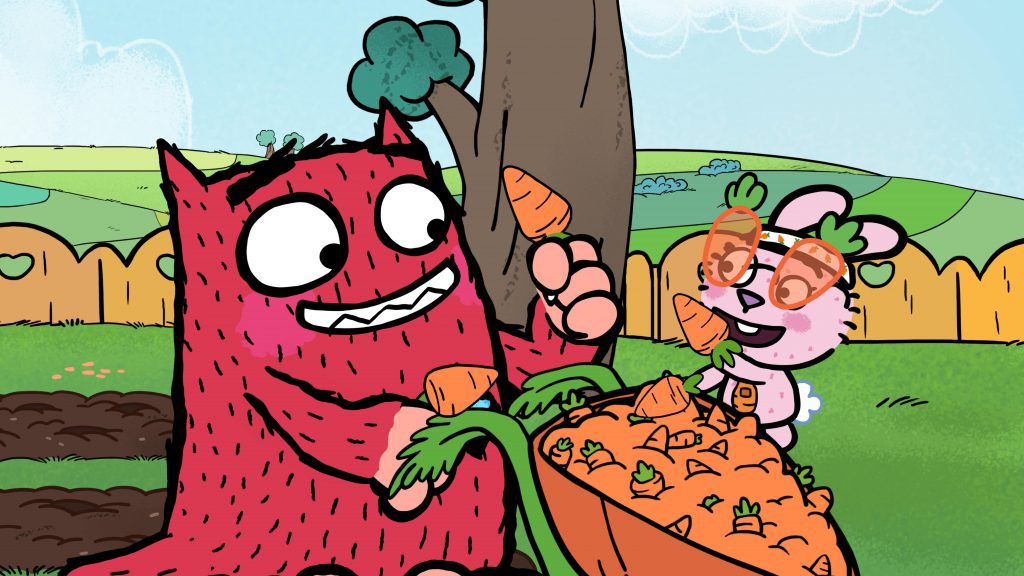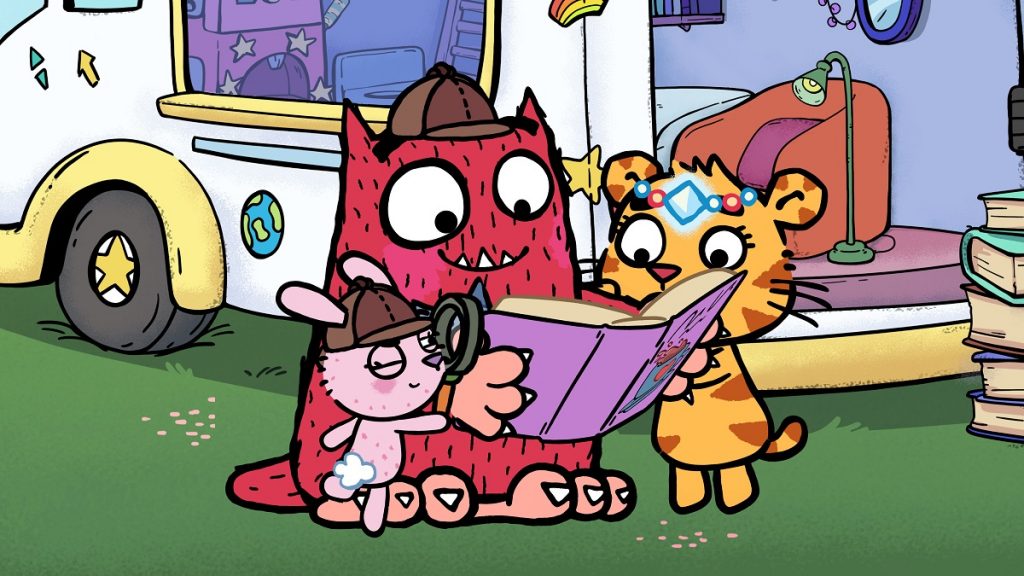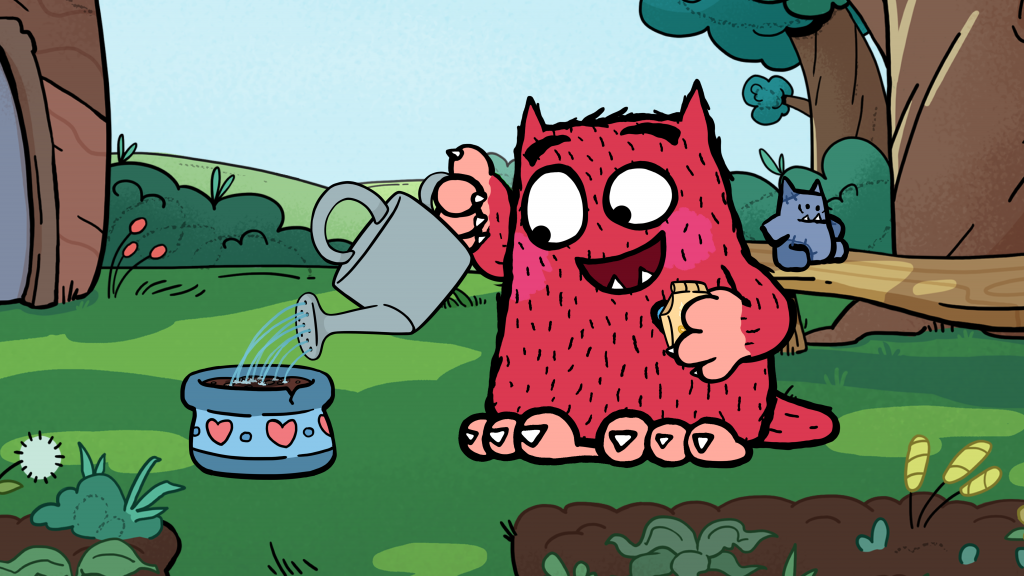[AD] As we get ready to send our children Back to Nursery/School after the extended break due to the current health crisis, anxiety levels are bound to be high and there will be lots of little life lessons to learn in the coming weeks.
As part of the Love Monster takeover, we asked Leah Brennan at Mindscape Psychology, a Chartered Clinical Psychologist with over 20 years’ experience in providing psychological treatments to children and their families to share her tips with us on how you can use Love Monster to help your children with little life learnings.

Leah feels that through Love Monster, children can learn about emotions – not only what they are, but also what to do with them. And parents can benefit too.
The series demonstrates to very young children that, actually, all feelings are ‘OK’ (not ‘good’ and ‘bad’!) and that it is important to identify and understand them and learn to tolerate them. For parents struggling to ‘fix’ perceived negative feelings such as anger and anxiety, and in a society that encourages ‘just getting on with it’, this a really important message to help in promoting better emotional wellbeing, starting with our children. The episodes also offer practical tips to help achieve this, particularly in emotional regulation such as helpful coping thoughts, relaxation strategies and graded exposure to feared tasks.
We asked Leah to pick Love Monsters episodes featuring common preschool problems and provides us with handy tips on how you can help your little ones overcome them.
Carrot Day
Carrot Day is all about Love Monster learning to try a new food.

In households this can be a smooth process, but in a lot of families it can be fraught with frustration, power battles and even tears, often from both sides. Interestingly, being reluctant to try new foods has an evolutionary basis. Once children were able to walk independently it was important for survival that they did not just pick up new foods and eat them as they could have been poisonous. For this reason, it is developmentally normal for children to become fussier around the toddler years.
Eating is a full sensory experience, as well as a social one and children’s experience of sensory input can vary, making new foods more challenging for those whose smell and taste is heightened.
Here are some useful phrases to help you to draw your child’s attention to the key coping skills in this episode whilst you watch it together:
- Help them identify feelings: “How do you think Love Monster feels about trying carrots?” / “He looks a bit worried about trying carrots doesn’t he?”
- Point out the key skill of repetition: “Love Monster is being brave by having a go at each type of carrot isn’t he!” / “He keeps trying, doesn’t he!”
- Show them that people can change their tastes/beliefs: “Even though he thinks he doesn’t like them, Love Monster is practicing trying them, isn’t he? I wonder if he’ll change his mind”.
- Highlight the change and link it to the skill: “He’s discovered he likes carrots now from all his trying!”
Supporting your child to include new foods into their diet will require you to be persistent but also patient.
Here are some ideas you might like to try at home:
- Be mindful of your language. Use the term ‘learning’ to imply that trying new foods is a process and can change e.g “Your learning to eat peas, just like Love Monster was learning to eat carrots.” Avoid saying things such as ‘you don’t eat peas do you’; this language is too rigid and does not give room for change.
- Remove any pressure to eat the new food, instead focus on increasing your child’s familiarity with the new food. It can take more than 10 trials of a new food for a child to develop enough familiarity to eat it.
- Be persistent. Keep putting a very small amount of the new food on your child’s plate alongside the foods you know they will eat. Be sure to let your child know that you do not expect them to eat it.
- Safely involve your child in food preparation, washing, collecting, peeling etc. This further increases familiarity, which will encourage tasting.
- Gradually expose your child to the food using all 5 of their senses. This might include touching, smelling, kissing or licking and then eventually nibbling, biting and swallowing the food. Stay at each stage until your child feels more comfortable before moving on to the next one.
- And, just like Love Monster, consider presenting food in different ways including raw (where appropriate) and cooked to change the texture.
Favourite Library Book Day
There are several important skills in this episode, including calming or settling our emotions before we try, solving problems and taking responsibility when you think you’ve done the wrong thing.

When you’re watching this episode with your child you can highlight these concepts. Elder Kitten teaches Love Monster and Tiniest Fluffiest Bunny to ‘fluff it out’ before deciding on a plan. You can draw your child’s attention to this by saying something like “Look they are calming their bodies down so they can think of a plan.” Remind your child when they are next experiencing an intense emotion that they too can ‘fluff it out’ to help their brain to calm down so they can think about solutions. Introduce this concept with comments like “Brains can’t think easily when they are full of big feelings, lets calm ours down first”.
You can also develop your child’s emotions vocabulary by highlighting the feelings in the character’s. Connect these to positive values by making comments such as “Even though Love Monster is really worried about what Book Cub will say, he is going to tell her he has lost it, that’s the right thing to do don’t you think?” This helps to instil your family values and expresses your expectation about acting in line with your values, even when emotions are tricky.
Here are some more ideas to try at home:
- Breathing exercise: Support your child to practice breathing slowly in and out through their nose. You can teach them to do their own version of ‘fluffing it out.’ Show them how to slowly draw an imaginary circle in front of them with their finger on an outstretched arm. Draw the circle from top to bottom on the ‘in’ breath and then from the bottom back up to top on the ‘out’ breath. Making the circle bigger helps them to breathe slower. Alternatively, they could raise their arms from their sides up slowly like butterfly / fairy on the ‘in’ breath and then down again slowly on the ‘out’ breath.
- Model calming your own emotions: Children learn from watching as you do, so be a great role model. Express your feelings aloud and comment about how you need to take some slow breaths and calm your big feelings before solving small problems or issues around the house. Then delight in watching them copy you.
Plant a Seed Day
Growing flowers or vegetables from seed can be so rewarding. Seeing all your effort result in something beautiful or edible can be thrilling, but it also takes patience. Learning how to wait is a hard task for younger children but a skill they need to exercise often, especially as they begin to mix with other children. Plant a Seed Day is a great example of learning to be patient and whilst you’re watching, take advantage of pointing out some key points to your child.

Comments such as ‘Love Monster is finding it hard to wait for his seeds, isn’t he? And then relating it to them personally ‘do you find it hard to wait sometimes?” This helps to encourage reflection and insight and also sets them up to notice when they might need help to be patient. This episode is also a wonderful example of imagination, something young children are great at. Encourage their creativeness by pointing out that imagination has no limits “Wow! A hot chocolate flower! If you could grow anything what would you grow?”
Some more ideas to try at home:
- Connect emotions to bodily feelings: notice when your child is struggling with patience and be curious about how it affects their body. You could say “It seems like it’s hard for you to wait, what is happening inside your body?” Help them observe if their legs are twitchy or they are jumpy like a jellybean. Connecting feelings and bodily responses helps children further understand their emotional experiences.
- Tolerating impatience: When you notice your child is struggling, you can remind them of Love Monster finding it hard to wait for his seeds to grow and being frustrated that TFB’s seeds had grown quicker. Help them to manage this emotion by getting them to remember what happened in the end – Love Monster’s seeds grew too, and they were amazing. You can say “I notice it’s hard to be patient at the moment, let’s think up some ideas to help you wait.” You could try ideas like distraction, helpful thoughts such as ‘I can wait’ or ‘It won’t be long’ or make up little games to play whilst you wait together.
Bouncy Slidey Day
Fear is something we all experience, no matter how old we are. Teaching young children strategies to manage fear sets them up with important lifelong skills. Make a point of highlighting the connection between feelings and bodily sensations. For example, you could say ‘Love Monster gets butterflies when he is worried, do you get butterflies too or does your tummy get more of a sick feeling?”. Pointing out that fear decreases the more we face it is another important lesson.

Help your child notice this by verbalising your own observations “Love Monster looks like he is enjoying it more now that he has done it a few times”. Introducing the concept of being brave to young children is also valuable. Children can learn that being brave is not about the absence of fear but instead about doing the behaviour, even when you’re feeling afraid. It also helps to normalise emotions, you could point out how that at the beginning Love Monster felt scared but later Tiniest Fluffiest Bunny was scared, and that everybody is scared sometimes. When children understand that it is OK to feel any feeling they are more likely to express their emotions verbally as they get older. You can extend these concepts at home by:
- Using the word brave in its true sense to encourage motivation. Adopt the language in everyday activities – “I noticed you felt scared to try to ride your scooter today, but you had a go anyway, that was brave.”
- Just like Love Monster did you can encourage your child to take small steps first when they are afraid. They might not be able to do the thing you really want them to (e.g go to a swimming lesson) but they feel able to do smaller building block type steps (e.g go along and watch the lesson). You can then build up in small steps first, gradually facing their fear over time.
Don’t forget you can watch Love Monster episodes over on the BBC iPlayer right now!






